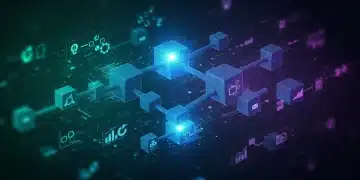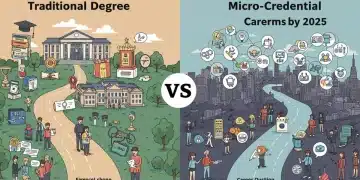Future-Proofing Education: Blockchain Credentials by January 2025

Integrating blockchain credentials into education by January 2025 offers secure, verifiable, and globally recognized academic records, addressing current challenges in traditional certification systems.
Future-Proofing Education: 5 Practical Solutions for Integrating Blockchain Credentials by January 2025 is no longer a distant concept but an immediate imperative. Educational institutions worldwide are now actively exploring and implementing blockchain technology to revolutionize how academic achievements are verified, stored, and shared. This shift promises enhanced security, reduced fraud, and greater accessibility for learners and employers alike.
The Urgency of Digital Transformation in Education
The global education landscape faces increasing pressure to adapt to digital advancements. Traditional credentialing systems, often paper-based or centralized digital databases, are vulnerable to fraud, difficult to verify quickly, and cumbersome for international mobility. The need for a robust, secure, and universally accepted method for academic record-keeping has never been more critical, especially as remote learning and global collaboration become standard.
As of late 2024, numerous pilot programs and early adoptions highlight the growing recognition of blockchain’s potential. Universities and vocational schools are investing in infrastructure to support these new systems, aiming for full integration within the next year. This proactive approach seeks to mitigate future challenges in credential verification and lifelong learning.
Addressing Verification Challenges
One of the primary drivers for blockchain adoption is the inherent difficulty in verifying traditional credentials. Employers often face delays and uncertainties when confirming qualifications, leading to inefficiencies in hiring processes. Blockchain offers an immutable ledger that can be instantly accessed and verified.
- Reduced Fraud: Blockchain’s cryptographic security makes credentials virtually impossible to forge.
- Instant Verification: Employers and institutions can verify credentials in seconds, not weeks.
- Global Recognition: Standardized blockchain credentials facilitate easier international mobility and recognition.
- Data Integrity: Ensures that academic records remain unaltered and accurate over time.
Solution 1: Standardized Blockchain Credential Platforms
Implementing standardized blockchain credential platforms is paramount for widespread adoption. These platforms would provide a common framework for issuing, storing, and verifying academic achievements across various institutions. This approach ensures interoperability and avoids fragmented systems that could hinder progress.
Several consortia and tech companies are currently developing such platforms. These efforts aim to create an ecosystem where a credential issued by one university can be easily recognized and validated by another, regardless of geographical location or institutional affiliation. This standardization is crucial for the seamless transition to a blockchain-powered education system.
Interoperability and Ecosystem Development
The success of blockchain credentials hinges on their ability to interact across different systems. This requires robust API development and adherence to common data standards. Without interoperability, the benefits of decentralized ledgers are significantly diminished, creating new silos instead of breaking down old ones.
Recent developments include collaborations between major tech firms and educational bodies to define these standards. The goal is to have a functional, widely adopted standard in place by early 2025, enabling a scalable solution for millions of students globally. This collaborative spirit is essential for overcoming technological hurdles.
Solution 2: Digital Wallets for Learner-Owned Records
Empowering learners with ownership of their academic records is a transformative aspect of blockchain credentials. Digital wallets allow students to securely store, manage, and share their credentials as they see fit, giving them complete control over their educational data. This shift moves away from institutions as sole custodians to a learner-centric model.
These digital wallets, often mobile-based applications, are designed with user-friendliness in mind. They integrate seamlessly with various blockchain platforms and provide intuitive interfaces for sharing credentials with potential employers, other educational institutions, or professional bodies. This portability and control are key benefits for the modern learner.
Enhancing Data Privacy and Control
Data privacy is a significant concern in the digital age. Digital wallets built on blockchain technology provide enhanced privacy by allowing individuals to control who accesses their data and for how long. This granular control is a stark contrast to traditional systems where personal data might be stored in multiple, less secure databases.
- Self-Sovereign Identity: Learners maintain complete control over their digital identity and credentials.
- Selective Disclosure: Users can choose to share specific credentials without revealing their entire academic history.
- Immutable Records: Once a credential is on the blockchain, it cannot be altered without cryptographic proof, ensuring authenticity.
- Reduced Administrative Burden: Students can manage their own records, reducing the need for institutions to process numerous transcript requests.
Solution 3: Micro-Credentialing and Lifelong Learning
The rise of micro-credentials, badges, and certifications for specific skills is a major trend in education. Blockchain is perfectly suited to support this movement, providing a verifiable and secure way to track and acknowledge continuous learning. This is particularly relevant in a rapidly evolving job market where lifelong learning is essential.
By January 2025, many institutions aim to integrate blockchain for issuing micro-credentials, making it easier for individuals to build a comprehensive digital portfolio of their skills. This granular approach to credentialing allows for greater flexibility and recognition of diverse learning pathways, beyond traditional degree programs.

Validating Non-Traditional Learning
Blockchain credentials extend beyond formal academic degrees to validate skills acquired through online courses, professional development programs, and even experiential learning. This broadens the scope of recognized achievements and provides a more holistic view of an individual’s capabilities.
This includes coding bootcamps, language certifications, and specialized technical skills. The ability to securely issue and verify these smaller, focused credentials empowers individuals to showcase their competencies effectively in a competitive global market. It also encourages continuous skill development and adaptation.
Solution 4: Enhanced Security and Anti-Fraud Measures
Security is a cornerstone of blockchain technology, making it an ideal solution for protecting sensitive academic records. The decentralized and cryptographic nature of blockchain significantly enhances anti-fraud measures, ensuring the integrity and authenticity of credentials. This is a critical upgrade from systems prone to tampering and counterfeiting.
Each credential recorded on a blockchain is cryptographically linked to the previous one, forming an immutable chain. Any attempt to alter a record would break this chain, immediately invalidating the credential and alerting stakeholders. This level of security is unmatched by traditional digital or paper-based systems.
Cryptographic Integrity and Audit Trails
The use of public-key cryptography ensures that only authorized issuers can create and sign credentials, and only authorized viewers can access specific information. Furthermore, every transaction and verification event creates an auditable trail, providing transparency and accountability.
- Immutable Records: Once entered, data on the blockchain cannot be changed or deleted.
- Decentralized Storage: No single point of failure, making the system more resilient to attacks.
- Transparent Verification: All verification requests and outcomes are recorded.
- Reduced Administrative Overhead: Less need for manual verification processes and fraud investigations.
Solution 5: Global Collaboration and Accreditation
The fragmented nature of global accreditation bodies and varying standards often complicates international recognition of academic qualifications. Blockchain credentials offer a pathway to streamline this process, fostering greater global collaboration and mutual recognition of educational achievements. This simplifies academic and professional mobility for individuals.
By establishing universally accepted standards for blockchain-issued credentials, educational institutions and governments can create a more cohesive global educational ecosystem. This would mean a degree earned in one country could be instantly recognized and validated in another, removing significant bureaucratic barriers.
Facilitating International Mobility
For students seeking to study abroad or professionals looking for international opportunities, the current system of verifying foreign credentials can be arduous and time-consuming. Blockchain dramatically simplifies this, providing immediate and trustworthy validation.
Discussions are underway among international educational bodies to establish a universal blockchain framework. This framework would allow for seamless transfer of credits and recognition of qualifications, boosting global talent mobility and enhancing collaborative research efforts. The target is to have initial agreements and pilot programs active by January 2025.
| Key Point | Brief Description |
|---|---|
| Standardized Platforms | Common frameworks for issuing and verifying credentials across institutions. |
| Learner Digital Wallets | Students control their academic records for secure sharing and management. |
| Micro-Credentialing | Blockchain for verifiable tracking of diverse skills and lifelong learning. |
| Enhanced Security | Cryptographic protection against fraud and ensuring data integrity. |
Frequently Asked Questions About Blockchain Credentials
Blockchain credentials are digital records of academic achievements stored on a decentralized, immutable ledger. They offer enhanced security, instant verification, and learner ownership, making them resistant to fraud and easily shareable globally.
Each blockchain credential is cryptographically secured and linked to previous entries, forming an unchangeable chain. Any attempt to alter a record would break this chain, immediately invalidating the credential and exposing the fraudulent attempt.
Yes, blockchain is ideal for micro-credentials. It provides a secure and verifiable way to track and acknowledge specific skills, courses, or training modules, allowing individuals to build comprehensive digital portfolios of their diverse competencies.
Digital wallets empower learners to securely store, manage, and share their blockchain credentials. This gives students complete control over their academic data, enabling them to decide who accesses their records and for what purpose, enhancing privacy.
While pilot programs are ongoing, significant widespread adoption of blockchain credentials is projected by January 2025. This timeline reflects ongoing standardization efforts, platform development, and increasing institutional buy-in for future-proofing education systems.
Looking Ahead
The rapid advancements in integrating blockchain credentials by January 2025 signify a pivotal moment for education. This isn’t just about digitizing diplomas; it’s about fundamentally reshaping trust, accessibility, and learner empowerment in academic verification. The ongoing developments point towards a future where educational achievements are universally recognized, securely managed by individuals, and instantly verifiable, eliminating traditional barriers. Stakeholders must continue to collaborate to ensure robust, interoperable solutions that truly future-proof education for generations to come, adapting to a world that demands agile and verifiable skill recognition.





